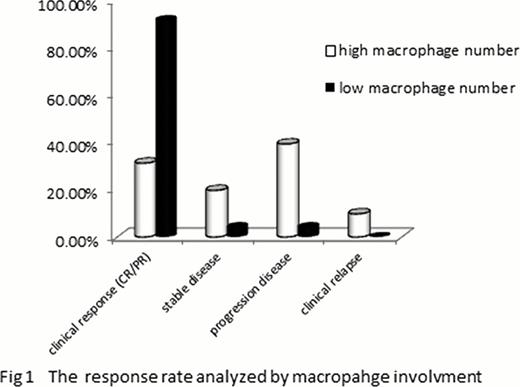Abstract
Abstract 4979
Recently the essential role of macrophages in the drug resistance or pathogenesis of plasma cell myeloma has gradually been identified and investigated. Here we analyzed patients diagnosed as multiple myeloma in West China Hospital, Si Chuan University, China in the past 3 years. The study involved 156 patients, aged 34–81 year old, mean age 60. 4 year old, male to female ratio is 1. 47:1, including 2 and 3 stages of myeloma according to International Staging System. The therapeutic response was evaluated on the basis of criteria of International Myeloma Working Group Uniform Response Criteria in patients who had completed 3 therapeutic dexamethasone- containing cycles. We observed the involvement of macrophages in bone marrow by immunohistochemical staining of anti-CD68 monoclonal antibody (DAKO). During the observation, two pathologists without any knowledge of clinical data find the “hot spot ” of myeloma cells and then enumerated the number of macrophage in “ hot spots ” under 400 magnification. Interestingly, patients with more macrophage involvement (>40/hp) in bone marrow showed poorer response (including PR, VGPR and CR after 3 cycles of chemotherapy) (31. 2%) to Dexamethasone-containing chemotherapy and higher incidence of disease progression-related deaths. On the contrary, the patients with lower macrophage involvement demonstrated much better response (91. 6%) to chemotherapy and persistent remission (figure 1 the response rate analyzed by macrophage involvement).
In summary, the difference of macrophage involvement in bone marrow of multiple myeloma patients with distinct prognosis suggested the macrophage inside bone marrow play a role in myeloma pathogenesis and therapeutic response.
No relevant conflicts of interest to declare.
Author notes
Asterisk with author names denotes non-ASH members.


This feature is available to Subscribers Only
Sign In or Create an Account Close Modal